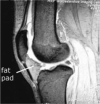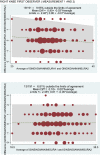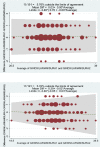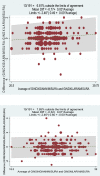Hoffa's fat pad thickness: a measurement method with sagittal MRI sequences
- PMID: 33772711
- PMCID: PMC8154775
- DOI: 10.1007/s11547-021-01345-9
Hoffa's fat pad thickness: a measurement method with sagittal MRI sequences
Abstract
Background: Hoffa's fat pad is a structure located within the fibrous joint capsule of the knee joint, but outside the synovial cavity. It plays an important biomechanical and metabolic role in knee joint, reducing the impact of forces generated by loading and producing cytokines. Changes in its size can induce modifications in the knee homeostasis. However, a great variability exists regarding its measurements. This work aims to evaluate the reliability of a measurement method of Hoffa's fat pad dimensions through MRI.
Methods: 3T sagittal IW 2D TSE fat-suppressed MRI sequences, taken from the OAI (Osteoarthritis initiative) database, of 191 male and female patients, aged between 40 and 80 years, were analysed; a manual measurement of the thickness of Hoffa's fat pad of each subject was then performed by two different readers. The interobserver reliability and intraobserver reliability of the measurements were described by coefficient of variation (CV), Pearson correlation and Bland-Altman plots.
Results: All statistical analyses have shown that not significant intra- or interobservers differences were evident (intraobserver CV % for the first observer was 2.17% for the right knee and 2.24% for the left knee, while for the second observer 2.31% for the right knee and 2.24% for the left knee; linear correlation was for the first observer r = 0.96 for the right knee and r = 0.96 for the left knee, while for the second observer r = 0.97 for the right knee and r = 0.96 for the left knee; in addition, the interobserver CV % was 1.25% for the right knee and 1.21% for the left knee and a high interobserver linear correlation was found: r = 0.97 for the right knee and r = 0.96 for the left knee). All results suggest that this manual measurement method of Hoffa's fat pad thickness can be performed with satisfactory intra- and interobserver reliability.
Conclusions: Hoffa's fat pad thickness can be measured, using sagittal MRI images, with this manual method that represents, for his high reliability, an effective means for the study of this anatomical structure.
Keywords: Hoffa’s fat pad; Infrapatellar fat pad; Knee joint; MRI; OAI.
Conflict of interest statement
The authors have no conflicts of interest to declare.
Figures





Similar articles
-
Hoffa's Fat Pad: Evaluation on Unenhanced MR Images as a Measure of Patellofemoral Synovitis in Osteoarthritis.AJR Am J Roentgenol. 2009 Jun;192(6):1696-700. doi: 10.2214/AJR.08.2038. AJR Am J Roentgenol. 2009. PMID: 19457837
-
Magnetic resonance imaging of Hoffa's fat pad and relevance for osteoarthritis research: a narrative review.Osteoarthritis Cartilage. 2016 Mar;24(3):383-97. doi: 10.1016/j.joca.2015.09.018. Epub 2015 Oct 9. Osteoarthritis Cartilage. 2016. PMID: 26455999 Review.
-
[Hoffa's disease of the adipose pad: magnetic resonance versus surgical findings].Radiol Med. 1998 Apr;95(4):278-85. Radiol Med. 1998. PMID: 9676203 Italian.
-
Comparison of the effectiveness of intra-infrapatellar fat pad and intra-articular glucocorticoid injection in knee osteoarthritis patients with Hoffa's synovitis: protocol for a multicentre randomised controlled trial.BMJ Open. 2025 Jan 28;15(1):e087785. doi: 10.1136/bmjopen-2024-087785. BMJ Open. 2025. PMID: 39880431 Free PMC article.
-
Inflammation of the infrapatellar fat pad.Joint Bone Spine. 2016 Jul;83(4):389-93. doi: 10.1016/j.jbspin.2016.02.016. Epub 2016 Apr 7. Joint Bone Spine. 2016. PMID: 27068617 Review.
Cited by
-
The thickness change ratio and preservation ratio of the infrapatellar fat pad are related to anterior knee pain in patients following medial patellofemoral ligament reconstruction.J Orthop Surg Res. 2024 Jun 25;19(1):375. doi: 10.1186/s13018-024-04853-2. J Orthop Surg Res. 2024. PMID: 38918867 Free PMC article.
-
Knee adipose tissue: from its implication in osteoarthritis to its supposed role in tissue engineering.NPJ Aging. 2025 Feb 3;11(1):5. doi: 10.1038/s41514-025-00195-3. NPJ Aging. 2025. PMID: 39900591 Free PMC article.
-
Quantitative MRI reveals infrapatellar fat pad changes after running a marathon.PeerJ. 2025 Mar 20;13:e19123. doi: 10.7717/peerj.19123. eCollection 2025. PeerJ. 2025. PMID: 40124601 Free PMC article.
-
Multimodality Imaging Assessment of Desmoid Tumors: The Great Mime in the Era of Multidisciplinary Teams.J Pers Med. 2022 Jul 16;12(7):1153. doi: 10.3390/jpm12071153. J Pers Med. 2022. PMID: 35887650 Free PMC article. Review.
-
Infrapatellar fat pad as a source of biomarkers and therapeutic target for knee osteoarthritis.Arthritis Res Ther. 2025 Apr 5;27(1):81. doi: 10.1186/s13075-025-03517-8. Arthritis Res Ther. 2025. PMID: 40188073 Free PMC article. Review.
References
-
- LaPrade RF. The anatomy of the deep infrapatellar bursa of theknee. Am J Sports Med. 1998;26:129e32. - PubMed
-
- Clockaerts S, Bastiaansen-Jenniskens YM, Runhaar J, Van Osch GJ, Van Offel JF, Verhaar JA, et al. The infrapatellar fat pad should be considered as an active osteoarthritic joint tissue: a narrative review. OsteoarthrCartil. 2010;18:876e82. - PubMed
Publication types
MeSH terms
LinkOut - more resources
Full Text Sources
Other Literature Sources
Medical

